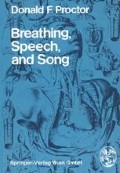Abstract
In contrast to the problems which we have just discussed the question of the voice in trouble in spite of reasonable attention to vocal hygiene may offer a knotty problem indeed. This chapter is directed at the voice in trouble and the multiple considerations necessary for detection of the cause as well as, whenever possible, restoration of normal function. Prompt and proper attention to these individuals is particularly urgent for two reasons. First, from the vocal point of view these persons are at least partially incapacitated. Second, the longer the voice problem persists the greater the likelihood or irreversible damage to the vocal folds. Obviously much of what is said in this last chapter must be directed to those on whom the responsibility falls for detection and correction of faults in the phonatory mechanisms; but the wise voice student, mature singer, or professional speaker should know enough to at least recognize the individual who pursues a reasonable course in diagnosis and therapy (8, 12, 16, 17, 18).
Access this chapter
Tax calculation will be finalised at checkout
Purchases are for personal use only
Preview
Unable to display preview. Download preview PDF.
References
Amado, J. H. (1954): Modifications des caractéristiques phonatoires sous l’influence de divers états endocriens. Rev. Laryngol. Suppl. 75, 235-250.
Amado, J. H. (1955): Glandes endocrines et phonation l’endocrino-phoniatrie. Conférence du Palais de la Découverte, Série A, 211, 1–48.
Bauer, H. (1967): Der Einfluß endokriner Störungen auf die Stimme. Wien. klin. Wschr. 79, 850–853.
Bicknell, P. G. (1973): Mild hypothyroidism and its effects on the larynx. J. Laryngol. 87, 123–127.
Bloch, C. S., Gould, W. J. (1974): Vocal therapy in lieu of surgery for contact granu-loma: A case report. J. Speech Hearing Dis. 39, 478–485.
Brewer, D.W., Briess, F. B., Faaborg-Andersen, K. (1960): Phonation, Clinical testing versus electromyography. Ann. Otol. 69, 781–804.
Brodnitz, F. S. (1963): Goals, results and limitations of vocal rehabilitation. Arch. Otolaryngol. 77, 148–156.
Brodnitz, F. S. (1960): Actor and singer as patients of the otolaryngologist. Trans. Amer. Acad. Ophth., Instruction Section, Course 414.
Ferguson, G. B. (1977): Speech and voice changes that aid in diagnosis. Trans. Amer. Acad. Ophth. 84, 90–91.
Frable, M. A. (1962): Hoarseness, a symptom of pre-menstrual tension. Arch. Otolaryngol. 75, 66–68.
Goldman, J. L., Salmon, V.J. (1942): Effect of androgen therapy on voice and vocal cords of adult women. Ann. Otol. 51, 961–994.
Greene, M. C. L. (1964): The Voice and its Disorders. Philadelphia: J. B. Lippincott.
Haglund, S. (1973): Electromyography in the Diagnosis of Laryngeal Motor Disorders. Stockholm.
Härmä, R., Sonninen, A., Vartiainen, E., Haveri., P., Väisänen, A. (1975): Vocal polyps and nodules. Folia Phoniatr. 27, 19–25.
Hirano, M., Koike, Y., Leden, H. v. (1968): Maximum phonation time and air usage during phonation. Clinical study. Folia Phoniatr. 20, 185–201.
Macfie, D. D. (1966): Asymptomatic laryngoceles in wind-instrument bandsmen. Arch. Otolaryngol. 83, 270–275.
Moore, G. P. (1976): Observations on laryngeal disease, laryngeal behavior and voice. Ann. Otol. 85, 553–564.
Moses, P. J. (1963): Der Laryngologe und die neueren Probleme des Singens. Z. Laryngol. Rhinol. Otol. 42, 445–452.
Proetz, A. W. (1950): Further observations of the effects of thyroid insufficiency on the nasal mucosa. Laryngoscope 60, 627–633.
Sander, E. K. (letter) (1975): Reply to Bloch and Gould’s “Vocal therapy”. J. Speech Hearing Dis. 40, 544.
Sonninen, A. (1970): La voz en el mongolismo y en el hipotiroidismo. Fonoaudiologica 16, 357–370.
Ward, P. H., Berci, G., Calcaterra, T. C. (1977): Superior laryngeal nerve paralysis. Trans. Amer. Acad. Ophth. 84, 78–89.
Zerffi, W. A. C. (1935): Vocal nodules and crossed arytenoids. Laryngoscope 45, 532 to 534.
Author information
Authors and Affiliations
Rights and permissions
Copyright information
© 1980 Springer-Verlag Wien
About this chapter
Cite this chapter
Proctor, D.F. (1980). Detection and Correction of Faults. In: Breathing, Speech, and Song. Springer, Vienna. https://doi.org/10.1007/978-3-7091-3737-6_10
Download citation
DOI: https://doi.org/10.1007/978-3-7091-3737-6_10
Publisher Name: Springer, Vienna
Print ISBN: 978-3-7091-3739-0
Online ISBN: 978-3-7091-3737-6
eBook Packages: Springer Book Archive

